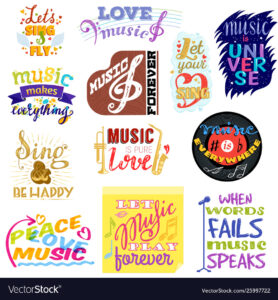Musical Typography: Where Letters and Music Converge

Musical typography is a dynamic intersection of sound and visual design—a creative discipline where typefaces not only convey written language but also evoke the rhythm, mood, and energy of music. In this realm, letters and symbols are crafted to resonate with musical themes, merging the art of typography with the expressive power of musical elements. Whether featured on album covers, concert posters, or in kinetic lyric videos, musical typography transforms the way we experience both text and sound.
1. Defining Musical Typography
At its core, musical typography involves the integration of musical motifs—notes, clefs, staffs, and rhythmic symbols—into the design of typefaces. It goes beyond simply selecting a stylish font; it’s about creating a visual language that mirrors the cadence and emotion of music. This form of design has the power to set a tone even before the first note of a song is heard, ensuring that the viewer’s visual experience is in harmony with the auditory one.
2. The Historical Roots and Evolution
The relationship between music and visual symbols is as old as musical notation itself. Early manuscripts featured calligraphic renderings of music, where ornamentation and letterforms conveyed both information and aesthetic appeal. As music evolved, so too did its visual representation. Today, musical typography borrows from this historical context while infusing modern graphic sensibilities and digital innovations. Modern tools have empowered designers to experiment with intricate details, dynamic layouts, and playful integrations of musical symbols alongside traditional letterforms.
3. Design Principles in Musical Typography
Creating a compelling musical typographic design involves balancing several key elements:
- Harmony and Rhythm: Just as a well-composed piece of music relies on rhythm and balance, effective musical typography aligns the weight and structure of letterforms with visual cues drawn from musical elements. This might mean integrating the graceful curves of a treble clef within the strokes of a letter or aligning the spacing of text to mimic musical measures.
- Mood and Emotion: Fonts evoke feelings. A heavy, bold typeface might suggest the intensity of rock or metal, while a delicate, script style might evoke the softness of classical or acoustic music. Musical typography leverages these inherent emotional cues and amplifies them through additional musical symbols and design flourishes.
- Legibility and Creativity: While creative experimentation is encouraged, ensuring legibility remains paramount. Designers must strike a balance between incorporating decorative musical details and maintaining clear, readable text. This balance is crucial whether the design is used for event promotion, album art, or digital media.
- Kinetic and Interactive Elements: In digital formats, musical typography often takes on a kinetic dimension. Animated lyric videos or interactive websites can synchronize the movement of text with musical beats, creating an immersive experience that draws viewers into a seamless audio-visual narrative.
4. Applications and Real-World Examples
Musical typography plays a significant role in various creative fields:
- Album and Single Covers: Artists and designers use musical typography to visually represent the energy and style of a record. For instance, a vintage, ornate font paired with subtle musical notation can evoke nostalgia, while bold, dynamic lettering might be chosen for a high-energy pop or hip-hop release.
- Concert Posters and Promotional Materials: In the realm of live music, posters and flyers often rely on musical typography to catch the eye and set the stage even before the event begins. The creative use of letterforms intertwined with musical symbols can create an instantly recognizable aesthetic that speaks to fans.
- Kinetic Typography in Music Videos: One of the most innovative applications of musical typography is seen in lyric videos. Here, words not only appear on screen but often interact with the beat, pulse, and flow of the song. This dynamic approach transforms static text into an integral part of the musical experience.
- Merchandising and Branding: From T-shirts and posters to digital banners and social media graphics, fonts that draw inspiration from music add a distinctive touch to a brand’s identity. Musical typography can serve as a visual shorthand for a band’s style or a music festival’s ethos.
5. Tools, Resources, and Inspiration
Designers looking to explore musical typography have a wealth of resources at their fingertips. Websites like 1001 Fonts and FontSpace offer extensive libraries of free music-inspired fonts. These resources provide a jumping-off point for designers to experiment with various aesthetics—from vintage calligraphy to modern, minimalist designs that incorporate musical notation.
Moreover, design communities and social media platforms are rich with inspiration. Observing how contemporary artists integrate type and music in innovative ways can spark new ideas, whether you’re redesigning a logo, creating a poster, or experimenting with animated typography for digital platforms.
6. Looking to the Future
As digital tools and interactive technologies continue to evolve, the future of musical typography holds exciting possibilities. Emerging trends include:
- Variable Fonts: These flexible typefaces allow for dynamic adjustments in weight, width, and even style—opening up new avenues for creating responsive designs that change in real time with the music.
- Augmented Reality (AR) Experiences: Imagine an AR application where text and musical symbols appear in your physical space, interactive and synchronized with live music. This blend of the tangible and the digital could revolutionize live performances and fan experiences.
- Enhanced Kinetic Typography: As animation software advances, kinetic typography will become even more integrated with music production, allowing bespoke visual performances that are tailor-made for each song.
Conclusion
Musical typography is a captivating fusion of sight and sound—a creative medium where letters sing and visual designs resonate with the pulse of music. It’s a field that invites endless experimentation, whether you’re crafting album art, designing concert posters, or developing interactive digital experiences. By drawing on both historical traditions and modern innovations, musical typography continues to shape how we perceive music and express our visual identities.
Comments are closed